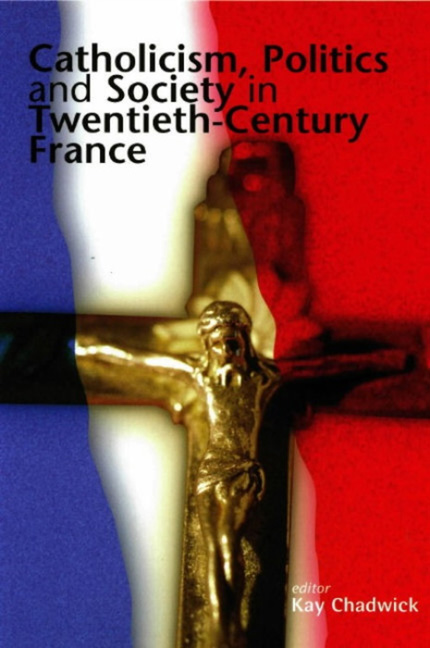Book contents
- Frontmatter
- Contents
- Editor's preface
- Notes on contributors
- Abbreviations
- Introduction
- 1 La laïcité en France au vingtième siècle
- 2 Antisémitisme des catholiques au vingtième siècle: de la revendication au refus
- 3 Catholicism and Nationalism: the Fédération républicaine, 1927–39
- 4 True and false modernity: Catholicism and Communist Marxism in 1930s France
- 5 Ralliés and résistants : Catholics in Vichy France, 1940–44
- 6 Les formes politiques de la démocratie chrétienne en France au vingtième siècle
- 7 Catholicism and the Left in twentieth-century France
- 8 Accueillir l'étranger : immigration, integration and the French Catholic Church
- 9 Yeast in the dough? Catholic schooling in France, 1981–95
- 10 Les femmes catholiques: entre Église et société
- 11 La sociologie religieuse du catholicisme français au vingtième siècle
- 12 Secularisation and the (re)formulation of French Catholic identity
- Select bibliography
- Index
9 - Yeast in the dough? Catholic schooling in France, 1981–95
- Frontmatter
- Contents
- Editor's preface
- Notes on contributors
- Abbreviations
- Introduction
- 1 La laïcité en France au vingtième siècle
- 2 Antisémitisme des catholiques au vingtième siècle: de la revendication au refus
- 3 Catholicism and Nationalism: the Fédération républicaine, 1927–39
- 4 True and false modernity: Catholicism and Communist Marxism in 1930s France
- 5 Ralliés and résistants : Catholics in Vichy France, 1940–44
- 6 Les formes politiques de la démocratie chrétienne en France au vingtième siècle
- 7 Catholicism and the Left in twentieth-century France
- 8 Accueillir l'étranger : immigration, integration and the French Catholic Church
- 9 Yeast in the dough? Catholic schooling in France, 1981–95
- 10 Les femmes catholiques: entre Église et société
- 11 La sociologie religieuse du catholicisme français au vingtième siècle
- 12 Secularisation and the (re)formulation of French Catholic identity
- Select bibliography
- Index
Summary
BACKGROUND INFORMATION
In 1992–93, there were 2,043,054 pupils in Catholic schools in France: 895,210 of them were in nursery and primary schools; 1,104,694 were in secondary schools (collèges, ages 11–15, and lycées, ages 15–18: the ages are indicative only because redoublement, or repeating of a year, is common in France); 43,150 were in agricultural schools and colleges. Apart from indicating that Catholic schooling in France is a substantial enterprise, these figures have little meaning until they are compared with those from other parts of the system. As soon as such cross-sector comparisons are made, certain inferences can be drawn. First, that Catholic schools dominate the private sector where they constitute 95% of all schools other than State schools. Secondly, that Catholic primary schools educate 13.4% of the total school population in that age group. From the age of compulsion (six), the Catholic primary school caters for about 15% of the available child population, while Catholic preschooling absorbs only 12% (it should be remembered that in France virtually all children are in school from age three). This 3% gap between pre-school and primary phases reflects the Church's problem in finding resources to build facilities in new estates, for example, where young children are to be found in large numbers. Thirdly, that Catholic collèges cater for 20.01% of all pupils in school at that level. Fourthly, that Catholic lycées cater for 19.15% of all pupils in school at that level. Finally, that the proportion of pupils passing through the Catholic system is thus somewhat higher at secondary than at primary level.
In spatial terms, these pupils are not spread evenly round France. Metropolitan France is divided into twenty-six académies, or educa- tional regions. Only 4.03% of primary children in the Strasbourg académie are in Catholic schools; in Nantes the figure is 37.63% and in Rennes 38.36%. At secondary level, Nantes (39.76%) and Rennes (42.93%) retain their pre-eminence as bastions of Catholic schooling, but Limoges (9.44%) is beaten to bottom place by Corsica (7.52%). Such figures reflect historical patterns. Two hundred years ago, the rural West (Nantes, Rennes) was the centre of popular resistance to the Revolution, and remains strongly Catholic…
- Type
- Chapter
- Information
- Catholicism, Politics and Society in Twentieth-Century France , pp. 197 - 218Publisher: Liverpool University PressPrint publication year: 2000



